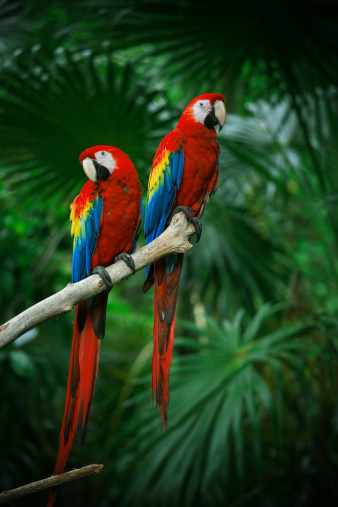ANIMAL: Scarlet Macaw Ara macao Type of Animal: Parrot Habitat: Rainforest, humid evergreen forest, lowland forest, tall deciduous forest, tall deciduous trees near rivers, gallery woodland, open woodland, mangrove vegetations, river edges, savanna Location(s): Native to E & S Mexico, Central America, N & C South America, & Trinidad & Tobago. Introduced in Florida. Appearance: Very colorful bird, mostly red to scarlet bird w/ yellow feathers, larger Central American scarlet macaws have blue on wings, South American subspecies has green on wings, some specimens have blue & green on wings, whitish upper mandible, black lower mandible, very long tail. Somewhat similar appearance to green-winged macaw but smaller/more colorful. Food/Diet: Nuts, berries, seeds, leaves, fruit, plant matter, stems, flowers, nectar, clay, insects, insect larvae, snails Status in Wild: Stable Conservation: Breeding in zoos, aviculture, & wildlife centers. Reintroductions into areas w/ low populations & parts of former range. Lifestyle: Flocks of 2-30 birds. Break off into monogamous pairs for breeding/nesting season. Additional Info: Called: Male: Cock Female: Hen Young: Chick Group: Flock Weight: Male: 2.3 lbs Female: 2 lbs Young: 0.9 oz Gestation: 1 month Life Span: 40-50 years in wild, 75-80 years in captivity Height: 2.67 ft Body Length: 2.67 ft Tail Length: 1.335 ft Main predators of adults are felids, snakes, crocodilians, tayra, coati, opossums, rats, raptors, & monkeys. Toucans, smaller monkeys, false vampire bats, corvids, & skunks prey on chicks. Strong beaks easily crack open nuts. Sexually mature at 2-3 years old. Chicks may stay w/ parents for up to a year. They have a 3 ft wingspan. Females lay 1-4 eggs. Ingest clay/minerals/sand/salt to help neutralize toxins in some of the food they eat. Often seen w/ green-winged macaws at clay licks. Due to diet, they play important role in seed dispersal. While stable, pet trade, hunting for feathers, habitat loss, & logging do take toll through range. National bird of Honduras. Bonded pairs often fly w/ wings nearly touching each other. Fun Fact(s): Like other macaws, they can mimic human speech. They can fly 35 mph. These macaws have a wide range of temperaments & can make decent pets. Like other macaws, they’re loud & high-maintenance. They can also outlive owners. Hybrid forms occur in captivity-Catalina macaws (hybrid of Scarlet & Blue-and-Gold Macaw) probably being the most popular.
